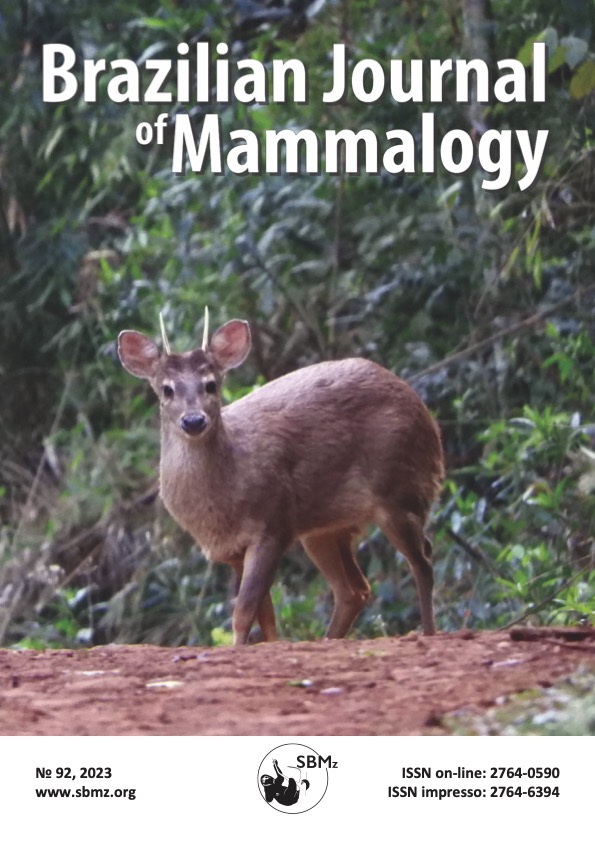Record of nesting material collection behavior in Metachirus myosuros (Didelphimorphia: Didelphidae)
DOI:
https://doi.org/10.32673/bjm.vi92.92Palabras clave:
Animal behavior, Atlantic Rainforest, Camera trap, Marsupial, OpossumsResumen
Records of collecting nest building material lack descriptions or are missing for most didelphids. We describe the tail use in this behavior in Metachirus myosuros on Atlantic Rainforest and compare it with similar behaviors reported for other didelphids. The behavior described here is like those reported for other closely related species, and likely can be traced at least to the last common ancestor of Didelphini and Metachirini (~15 Maa). However, scarcity of data on other taxa makes it impossible to state that this behavior was already present in the start of the Didelphidae clade.
Citas
Alvares CA, Stape JL, Sentelhas PC, Gonçalves JLM, Sparovek G. 2013. Köppen’s climate classification map for Brazil. Meteorologische Zeitschrift 22(6): 711-728. https://doi.org/10.1127/0941-2948/2013/0507
ASM - American Society of Mammalogists. 2023. ASM Mammal Diversity Database. Version 1.11. Available at: www.mammaldiversity.org. Accessed on: August 31, 2023.
Ceballos G. 1990. Comparative natural history of small mammals from tropical forests on Western Mexico. Journal of Mammalogy 71(2): 263-266. https://doi.org/10.2307/1382182
Dalloz MF, Loretto D, Papi BS, Cobra PPA, Vieira MV. 2012. Positional behaviour and tail use by the bare-tailed woolly opossum Caluromys philander. Mammalian Biology 77(5): 307-313. https://doi.org/10.1016/j.mambio.2012.03.001.
Delgado-V CA, Arias Alzate A, Aristizábal-Arango S, Sánchez-Londoño JD. 2014. Uso de la cola y el marsupio en Didelphis marsupialis y Metachirus nudicaudatus (Didelphimorphia: Didelphidae) para transportar material de anidación. Mastozoologia Neotropical 21 (1): 129-134. Available at: http://www.scielo.org.ar/scielo.php?script=sci_arttext&pid=S0327-93832014000100014&lng=es&nrm=is. Accessed on: December 14, 2023.
Earthcreat. 2022. Instagram 11 January 2022, [Instagram post]. Available at: instagram.com/p/CYmoIHVFh88/. Accessed on: December 08, 2022.
Faria MB, Lanes RO, Bonvicino CR. 2021. Marsupiais do Brasil: guia de identificação com base em caracteres morfológicos externos e cranianos. Sociedade Brasileira de Mastozoologia; Amélie Editorial, São Caetano do Sul.
Gardner AL, Dagosto M. 2008. Tribe Metachirini Reig, Kirsch, and Marshall, 1985. Pp. 35-39, In: Gardner AL, (Ed.), Mammals of South America Vol. 1 - Marsupials, Xenarthrans, Shrews and Bats. University of Chicago Press, Chicago.
González EM, Claramunt S. 2000. Behaviors of captive short-tailed opossums, Monodelphis dimidiata (Wagner, 1847) (Didelphimorphia, Didelphidae). Mammalia: 64(3) 271-286. https://doi.org/10.1515/mamm.2000.64.3.271
Hernández-Hernández JC, Chávez C. 2022. Philander opossum y Didelphis marsupialis usan la cola para transladar material vegetal. Mammalogy Notes: 8(1): 235. https://doi.org/10.47603/mano.v8n1.235
Hunsaker DII, Shupe D. 1977. Behavior of New World marsupials. Pp. 279-344, In: Hunsaker D. (Ed.) The biology of marsupials. Academic Press, New York.
Jansa SA, Barker FK, Voss RS. 2013. The early diversification history of didelphid marsupials: Window into South America’s “Splendid Isolation”. Evolution 68(3): 684-695. https://doi.org/10.1111/evo.12290
Loretto D, Ramalho E, Vieira MV. 2005. Defense behavior and nest architecture of Metachirus nudicaudatus Desmarest, 1817 (Marsupialia, Didelphidae). Mammalia 69(34): 417-419. https://doi.org/10.1515/mamm.2005.033
Marshall LG. 1978. Chironectes minimus. Mammalian species 109: 1-6. https://doi.org/10.2307/0.109.1
Miranda CL, Nunes MS, Machado AF, Farias IP, Menezes FH, Ardente NC, Santos-Filho M, Bredin YK, Silva MNF. 2023. A new species of Jupati, genus Metachirus Burmeister 1854 (Didelphimorphia, DIdelphidae) for the Brazilian Amazon. Mammalia 87:2. doi.org/10.1515/mammalia-2021-0176.
Oliver WLR. 1976. The management of Yapoks (Chironectes minimus) at Jersey Zoo, with observations on their behaviour. Annual Report Jersey Wildlife Preservation Trust 13: 32-36.
Szalay FS. 1995. Evolutionary history of the marsupials and an analysis of osteological characters. Cambridge University Press, Cambridge.
Unger KL. 1982. Nest-building behavior of the Brazilian bare-tailed opossum Monodelphis domestica. Journal of Mammalogy 63:160-162. https://doi.org/10.2307/1380687
Voss RS, Fleck DW, Jansa SA. 2019. Mammalian diversity and matses Ethnomammalogy in Amazonian Peru, Part 3: Marsupials (Didelphimorphia). Bulletin of the American Museum of Natural History 432: 1-87. https://doi.org/10.1206/0003-0090.432.1.1
Voss RS, Jansa SA. 2021. Opossums: An adaptive radiation of New World marsupials. John Hopkins University Press, Baltimore.
Voss RS. 2022. An Annotated checklist of recent opossums (Mammalia: Didelphidae). Bulletin of the American Museum of Natural History 455(1):1-76. https://doi.org/10.1206/0003-0090.455.1.
Descargas
Publicado
Cómo citar
Número
Sección
Licencia
Derechos de autor 2024 Brazilian Journal of Mammalogy

Esta obra está bajo una licencia internacional Creative Commons Atribución 4.0.


